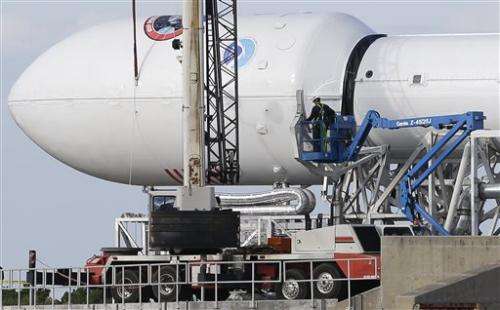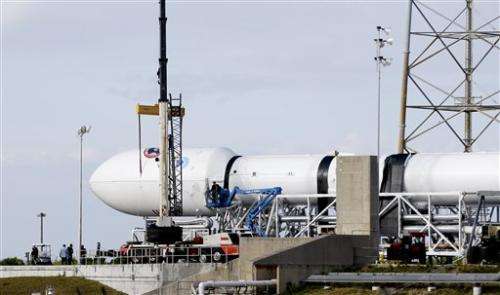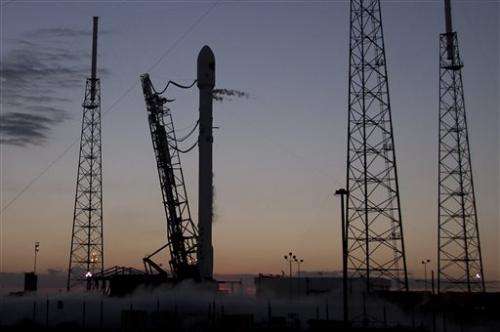SpaceX tries again to launch observatory, land rocket at sea (Update)

SpaceX is taking another stab Tuesday at launching an observatory into deep space and landing the rocket booster that carries it up.
The unmanned Falcon 9 rocket was set to blast off at sunset, with the ground-breaking ocean landing of the leftover booster planned for about 10 minutes later. But high wind threatened to delay the flight.
It was the private company's second attempt in three days to launch the Deep Space Climate Observatory for NASA, the National Oceanic and Atmospheric Administration and Air Force.
Last-minute radar trouble halted Sunday's countdown, then SpaceX skipped Monday because of rain.
"Extreme wind shear over Cape Canaveral," SpaceX's founder and chief executive Elon Musk reported Tuesday afternoon via Twitter. "Feels like a sledgehammer when supersonic in the vertical. Hoping it changes . "
Former Vice President Al Gore planned to return for the launch. It was his idea in 1998 to provide continuous views of Earth from afar that led to this space weather satellite.
The observatory, dubbed DSCOVR, will fly to a point 1 million miles from Earth in direct line with the sun to watch for incoming geomagnetic storms that could trigger power outages on Earth. This so-called Lagrange point, located 92 million miles from the sun, would provide as much as a one-hour lead time to prepare for potentially disruptive solar outbursts.

In addition, DSCOVR will provide a steady stream of pictures of the entire sunlit side of Earth, as Gore originally envisioned.
Sen. Bill Nelson, D-Florida, said from Washington that there hasn't been a full, sunlit picture of the Earth since Apollo 17 in 1972—NASA's last manned moon-landing mission. Subsequent images have been stitched together, he noted, for composite shots.
DSCOVR "will give us a new perspective of the overview effect of what this home is that we call Planet Earth, and what it looks like on a daily basis, every two hours," Nelson said Monday from the Capitol. The senator accompanied Gore for Sunday's try, but could not return.
The $340 million DSCOVR mission began as Gore's Triana, named after the lookout who first spotted land on Christopher Columbus' voyage to the New World. It was canceled for political reasons, however, and the spacecraft put in storage in 2001. NASA and NOAA resurrected it several years later and made the sun its primary mission, with Earth-gazing a secondary objective.
It will take DSCOVR nearly four months to travel the 1 million miles, and another month for checkout. That would put operations beginning in mid-summer.
In a repeat of a ground-breaking experiment, SpaceX will fly its leftover first-stage booster to a platform floating 370 miles off the Florida coast. Last month's test came close, but ultimately failed; the booster ran out of hydraulic fluid for the guidance fins, landed hard and tumbled into the Atlantic in flames.

SpaceX added extra hydraulic fluid for this second test, intended to demonstrate money-saving rocket reusability. But company officials warned the booster would be coming in faster this time from about 80 miles up, making it harder to nail the vertical touchdown. The odds of success remained no better than 50-50, officials said.
Musk intends to land boosters back on firm soil, once the operation is perfected. On Tuesday, officials at Cape Canaveral Air Force Station announced that SpaceX will lease an inactive launch complex once used to shoot off Atlas missiles, and convert it into its first-ever booster-landing pad.
"It's a whole new world," Brig. Gen. Nina Armagno, commander of the 45th Space Wing, said in a statement.
The first booster-landing attempt on Jan. 10 occurred during a SpaceX supply run to the International Space Station. Dragon, the unmanned cargo ship, coincidentally was scheduled to return home Tuesday.
Loaded with science samples, bad spacesuit parts and other broken equipment, the Dragon departed the space station four hours before the Falcon's planned liftoff. Splashdown was set to occur in the Pacific off the Southern California coast 1½ hours after the planned launch.
"Busy Tuesday," SpaceX noted in a tweet.
© 2015 The Associated Press. All rights reserved.





















